IDEX Online Research: Polished Diamond Prices Steady in May
June 03, 07
Global diamond prices took a pause from their steadily upward march during the month of May. After rising for the past five months on a month-to-month comparison, polished diamond prices fell modestly in May versus April, according to the IDEX Online Polished Diamond Price Index. However, on a year-over-year basis, diamond prices rose by a modest 1.6 percent in May 2007 versus the same month a year ago.
IDEX Online Research believes this may be the beginning of the slowdown in demand which we have been predicting for the past few months. Global economic growth is expected to slow during 2007. Since diamond demand and economic growth correlate closely, we expect diamond sales to cool moderately this year.
However, it is important to note that economic growth around the world is expected to be uneven. The U.S. is the primary drag on global economic growth. First quarter GDP has been revised significantly for the third time, and now stands at a paltry +0.6 percent. In contrast, Europe’s economy seems to be doing better than expected, and the Asian and Indian economies are firing on all cylinders.
Since U.S. diamond sales represent nearly half of the total global diamond sales, any hiccup in U.S. economic growth will have a ripple effect across the diamond industry.
The good news is that the diamond pipeline is not choked with goods. DTC Sights have averaged about 9 percent lower volume this year versus the same period last year. Thus, there is no extraordinary pressure coming from diamond miners to sell their rough stones.
As a result of the prospects of a slowing economy, most of the major American jewelry chains are planning for a conservative Holiday Selling Season (November-December) 2007. This two-month period represents about one-third of annual sales for U.S. specialty jewelers. If jewelers cut back on restocking, as expected, diamond demand is likely to remain soft for the next several months.
Based on IDEX Online’s current 2007 jewelry sales forecast for the U.S. market – +3-4 percent as measured by dollars through the cash register – and based on the current rate of jewelry price inflation at the retail level – more than 4 percent – it is likely that American jewelers will sell fewer units of jewelry this year.
 |
The IDEX Online Polished Diamond Price Index, calculated on the daily diamond prices for the month, fell to 111.95 in May 2007 from the prior month’s 112.07. The Index stood at 100 in July 2004; thus, polished diamond prices have risen about 12 percent over the past three years, or about 4 percent a year. After languishing early in the month, diamond demand and prices seemed to solidify later in the month. In short, depending on your point of view, polished diamond prices held steady, at best, or, they have reached an inflection point and could be weaker over the coming months.
 |
Diamond Price Rise Takes A Pause
During the month of May, polished diamond prices took a pause from their modest, but steady upward march. Our sense is that there is enough uncertainty among diamond jewelry suppliers concerning the near term outlook for the U.S. market. Further, the industry’s leading bank which provides more than 25 percent of the industry debt, appears to be poised to tighten its credit limits, both in response to soaring diamond industry debt as well as in response to the prospects that it will be sold to a buyer who may take a dim view of its relatively liberal diamond industry lending practices. Either way, diamond demand will remain under pressure until uncertainty becomes certainty.
The graph below summarizes the IDEX Online Polished Diamond Price Index since the beginning of 2005 through May 2007. As the graph illustrates, global polished diamond prices moved slightly lower in May.
IDEX Polished Diamond Price Index
2005 - 2007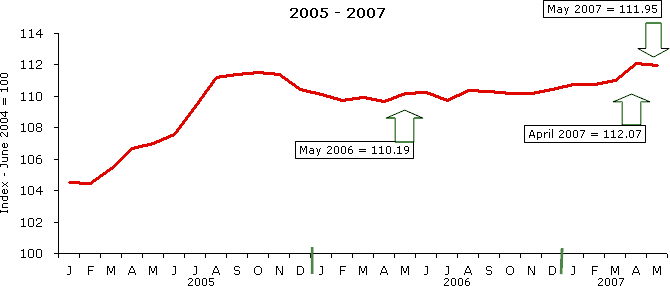
Source: IDEX Online Research
Month-to-Month Diamond Prices Down Modestly
The graph below illustrates the percentage change in global polished diamond prices on a month-to-month basis since the beginning of 2006. Comparisons are based on the daily average prices for the month for sizes of 0.10 carats and up and all qualities of polished diamonds, with the percentage change based on each month versus the immediate prior month (e.g. May 2007 versus April 2007).
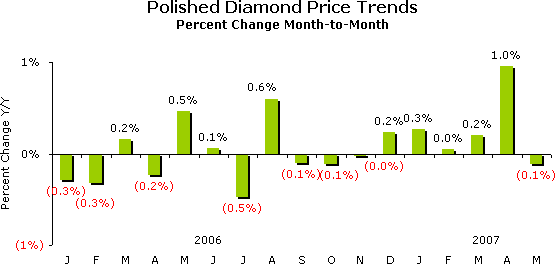
Source: IDEX Online
Year-to-Year Diamond Prices Show More Modest Gain
After rising steadily since the beginning of the year, polished diamond price gains slowed down in May. The graph below illustrates the percentage change in average monthly global polished diamond prices on a year-over-year basis. Comparisons are based on the daily average prices during the month versus the same month a year ago (e.g. May 2007 versus May 2006). The year-to-year comparison takes into account the seasonality of polished diamond demand and prices.
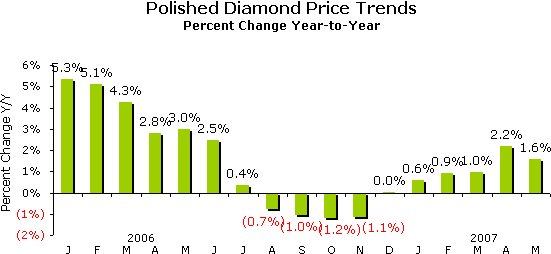 Source: IDEX Online |
Even Large Stone Demand Slowed
Retailers tell us that demand for larger diamonds is the single hotspot in the market. But polished diamond prices don’t necessarily reflect that observation. Other than demand for four-carat diamonds, prices were squishy for most other larger sizes two-carat and above.
During May, prices for almost all sizes of diamonds were about flat on a month-to-month basis, with the exception of the four-carat stones. Even five-carat stone prices showed no increase in price from the prior month.
The graph below summarizes the price change of polished diamonds by size during May 2007 versus April 2007. These six sizes of stones represent nearly one-third of the market volume by aggregate value.
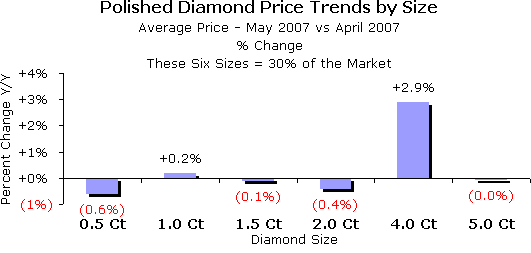
Source: IDEX Online
The graph below illustrates the price change for the same six key diamond sizes on a year-to-year basis (May 2007 versus May 2006).
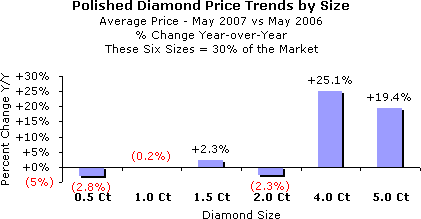 Source: IDEX Online |
Polished Diamond Price Outlook: Uncertainty
Economic cyclicality and diamond demand correlate closely. Most forecasters are calling for a slowing of the world’s economy during 2007. But this “global” forecast is misleading: of world’s major economies, only the U.S. is expected to show any real slowdown. Most other economies, especially those in developing nations such as India and China, are plowing ahead with phenomenal growth.
The challenge, though, is that the American market currently consumes about half of all diamond jewelry in the world. Thus, while its economy is less than 30 percent of global GDP, it is by far the most important market for diamantaires. As the U.S. goes, so goes the diamond industry. In short, diamantaires may want to hunker down until later this year.
In addition to a slowing economy putting a damper on diamond demand, many of the major U.S. jewelry chains have cut back on their sales budgets for the all-important Holiday Selling Season in November and December. Thus, their lack of increased demand will keep diamond prices in check.
Finally, if, in fact, diamond industry debt is at a choking point (how many times have we heard this in the past?), stone prices would be expected to rise due to fewer stones entering the market. How come? If there is no credit to finance operations, some diamond suppliers will go out of business. Thus, there could be less product in the market. Further, if the number of diamond suppliers really does diminish, the remaining participants could likely finally achieve some pricing power.
Recently, the DTC announced a price increase for its rough stones. We should have seen it coming: they cut their output earlier this year in an effort to allow the pipeline to clear. The wild card in their strategy, however, is demand. In a true demand-and-supply economy, the DTC customers would take fewer stones in the current environment, and the price increase might not hold. Unfortunately, we still have some difficulty using the terms “DTC” and “capitalism” in the same sentence.
Thus, DTC Sightholders can do little more than grumble about higher prices. DTC customers will have little choice other than to take the rough stones and hope that demand solidifies.
Here’s how this all plays out: short-term polished diamond prices are likely to be under pressure. But long term, polished diamond prices will continue their relentless climb upward, especially if the rough stone shortages that are predicted in the next few years actually materialize. Thus, we remain highly optimistic on the future of the diamond and jewelry industry.
The IDEX Online Diamond Price Index
The IDEX Online Diamond Price Index is a real-time index derived from actual asking prices in the global diamond industry. The IDEX Online Diamond Price Index objectively reflects price trends as they happen. The Diamond Index and Diamond Drivers were formulated following comprehensive research and analysis of the IDEX Online inventory database, aggregated since 2001. Research and development were conducted in cooperation with Dr. Avi Wohl, Senior Lecturer of Finance at the faculty of Management, Tel Aviv University, Israel.
Additional information is available from IDEX Online Research. The e-mail address is diamondprices at idexonline dot com.